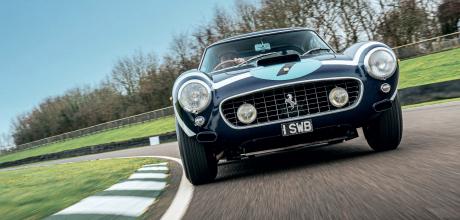Flat out in Stirling’s Moss 1961 Ferrari 250 SWB at Britain’s best-loved historic circuit
Despite being a brilliant machine, the first M5 Touring couldn’t generate enough enthusiasm within.
250 GT SWB TRACK TEST
We take a world-famous Ferrari racing car to its limit at Goodwood
At a deserted Goodwood, we attempt to recreate a well-known 1961 Stirling Moss racing photograph using the same – now extremely valuable – Ferrari 250 GT SWB
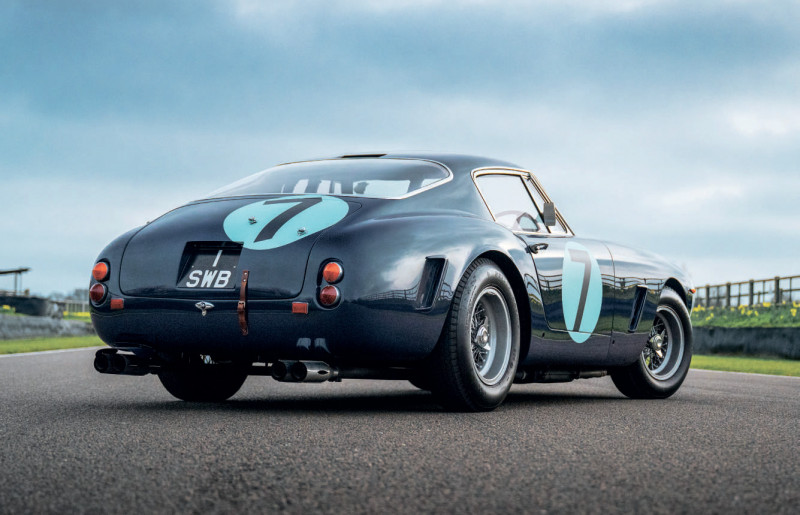
There are trickier corners than Madgwick at Goodwood, but not many. The approach is curved and unless you’re in something with elephantine amounts of downforce, some degree of braking will be required. But it is still quick. Really quick. And it’s crucial too, because your exit speed determines your pace down to Fordwater and, if you clench hard enough and manage to do that flat, all the way to the entry point to St Mary’s too.
There are two apexes but popular thinking says you can and probably should miss the first so long as you absolutely nail the second. But between them is less of a bump, more of a hump in the road, which you’d be forgiven for thinking had been put there for the express purpose of destabilising whatever you happen to be in, which in this case is the most valuable Ferrari 250 GT SWB in the world. Bearing in mind the least valuable SWB is a car worth many millions, it does focus the mind somewhat.

“Even today 300bhp is going to get your attention, but really it’s the noise, that howl”
But of course you don’t have to go fast. Just soak up the sight, the sound and the intoxicating fuel and oil smell of driving this car around that corner. Except, today, I can’t. There’s a picture my editor has briefed ace automotive photographer Jayson Fong to capture. It is a very particular image, requiring him to stand right on the edge of the circuit like they did when this car was new, which is why today we have the entire Goodwood circuit to ourselves. The picture we want to recreate is of this very car, at this very spot, but in late 1961, not early 2023 and with one Stirling Craufurd Moss at its wheel.
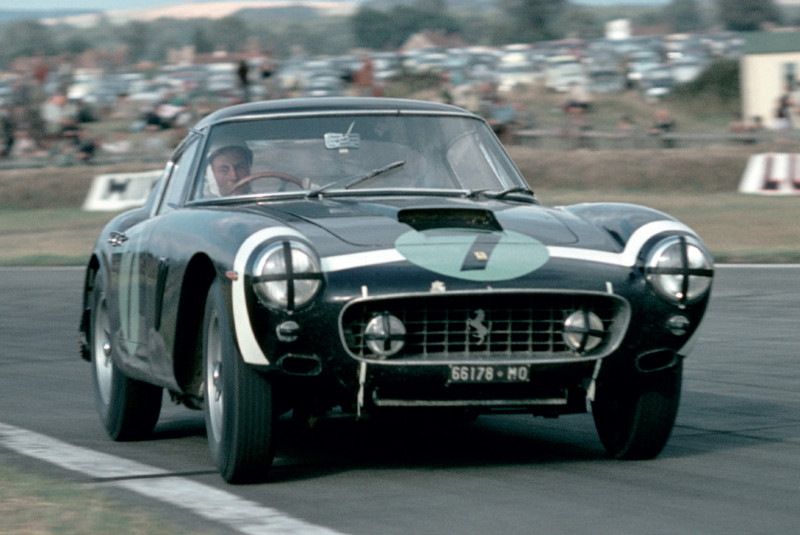
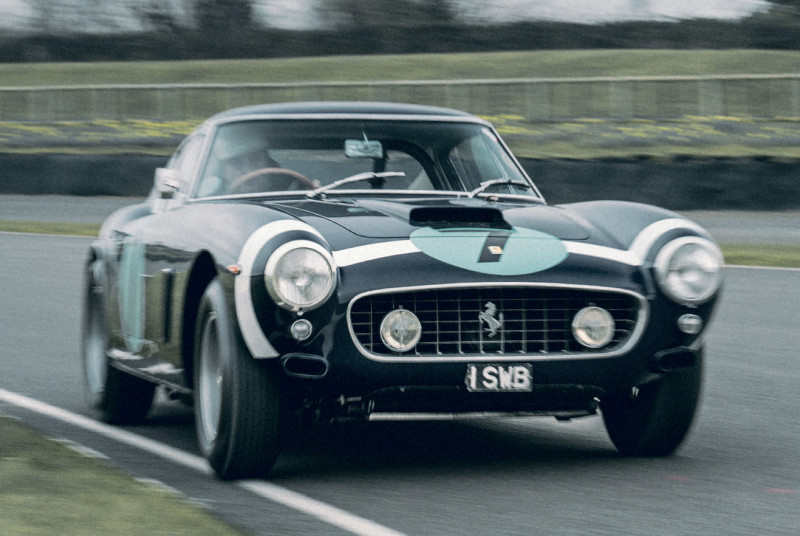
Why is this the most valuable Short Wheelbase of them all? Because it’s not just Stirling’s car, but the car in which he took his seventh and final TT victory in 1961, the very last time he raced at Goodwood before that accident. It is also, even by SWB standards, in ultimate specification. For this is not only an alloy-bodied Competizione model, but the ultimate ‘Comp/61’ model, probably better known as a ‘SEFAC Hot Rod’ and the only one built with right-hand drive. It was also made by a Ferrari keen as mustard to secure the services of Moss as a factory driver, which is why, while most racing SWBs had around 275bhp from their single cam, 3-litre Colombo V12 motors, the period dyno sheet for this one recorded 299bhp at 7700rpm, as much power on three carburettors as a decent GTO would manage the following season on six.
“The image of Stirling in this car at this very spot is as clear to me as the track ahead”
Ordered for Stirling by Rob Walker, 2735GT was delivered to Le Mans with sliding Perspex windows, blue carpets, a light grey headlining and Rob’s familiar blue with white stripe paintwork. The bill was 5.5m lira. Sharing with Graham Hill, they carved through the field and were in third place overall, a GT car ahead of several prototypes, when a fan blade detached itself, severing a radiator hose and blowing a head gasket. Half a century later Stirling was still livid. “It was Rob’s car but it’d been prepped and entered by NART (Luigi Chinetti’s North American Racing Team) and they’d left the bloody road car fan on the engine…” But the car itself he loved, his favourite of all the GT cars he drove.

He then raced it at Silverstone and Brands Hatch, winning outright and breaking the GT lap record on both occasions. Then came victory at Goodwood but if Stirling thought it would be a repeat performance of the previous year where in another Rob Walker SWB (now owned by Ross Brawn) he lapped the field while listening to the radio, he was soon to be disabused of that notion, a situation which would have delighted him. “I’m a racing driver,” he used to say, always with the emphasis on the adjective. Yes he liked to grind the opposition into the dust, but he loved a real race. And at Goodwood in 1961, he got one.
The opposition came from Mike Parkes, by no means a professional racing driver at that early stage of his career. But driving a similarly specified Maranello Concessionaires SWB, he was close to Stirling’s time in first practice then, when Moss flew north to turn on the Blackpool illuminations, took pole. The race turned into a battle between the two, Stirling seriously impressed by Parkes’ ability to hang onto his tail, the outcome determined not by raw speed but just how hard Parkes had to drive to keep up with the always effortless Moss. He wore out his tyres faster and Stirling ran out a quite comfortable winner.
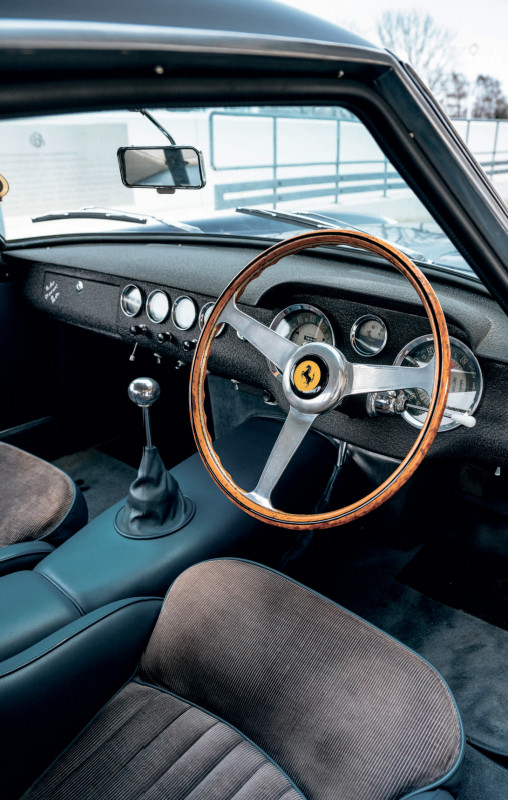
That was followed by victory in both heats and the finals in Nassau at the end of the year. In short, he raced the car six times and won every time he finished, which was all bar one of them.
It was then sold to the UDT Laystall team for which it raced twice in 1962 piloted by Innes Ireland, retiring through brake failure at Daytona in February and coming fourth at Oulton Park in April, breaking the GT lap record in the process. The car was then sold to Chris Kerrison who crashed heavily at the Goodwood TT, collecting in the process the 250 GTO of John Surtees and Jim Clark’s DB4 GT Zagato Aston Martin, which having connected earlier in the race had both been parked, substantially bent, in the barrier many laps previously. It was one of motor racing’s pricier pile-ups.
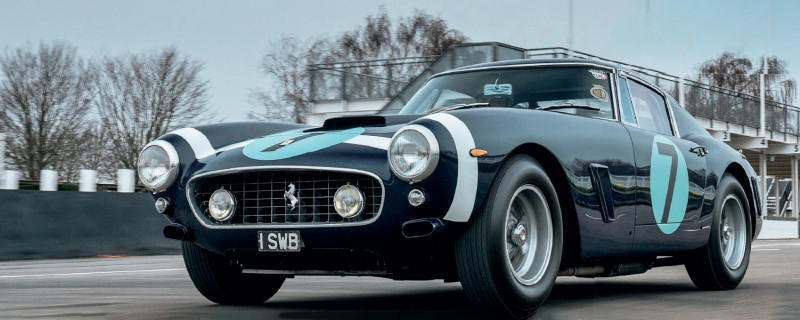
The car was sent back to Maranello to have its body repaired but when the bill came in it was so eye-watering the SWB was sent instead to Drogo where a new body super ficially similar to the famed Drogo ‘Breadvan’ was created for it. Kerrison raced it extensively through 1963 and ’64 before it was sold, going through a number of owners until bought by Clive Beecham in 1983 who had it rebodied as it was when new. In 2007 the car was sent to Maranello for a two-year body-off restoration during which it was ensured the car was identical to original configuration in both look and mechanical specification. All its other major components survive save its engine which, as was often the case back then, found its way into another car and is today missing presumed burned in a factory ire. Even so the motor fitted today is SEFAC Hot Rod correct in every respect and retains the three outsize, twin choke 46mm Weber carburettors from the original unit. Clive estimates it has somewhere north of 290bhp, which in a car weighing barely a tonne, is enough to be getting on with. What is it about the Short Wheelbase? For a start they mark the pinnacle point in Ferrari GT car engineering. By which I don’t mean I think the GTO that replaced it was a backward step – the very thought is absurd – but really it’s a GT in homologation terms alone. While the SWB is a road-going GT adapted for racing, the GTO is a racing car which, were it not for the clout and tenacity of Enzo Ferrari, would probably never have been classified as a GT. And this SWB, this actual car, is the ultimate development of Ferrari’s ultimate GT racer. And because of that, we’re going to drive it on the road first.

For Clive has not had it transported down to Goodwood in some vault-like transporter with armed guards in the back, he’s driven it out of London, around the M25 and down the A3 and A285 to meet me at Goodwood. He won’t drive it if there’s salt on the road, but otherwise he’s not remotely precious about the car and has taken it all over Europe.
It’s important to Clive that I experience it properly on the road so I climb behind that fabulous alloy spoked steering wheel, and only briefly wish I had Moss-like proportions. Head and legroom are limited to say the least. But when you have all those gorgeous Veglia dials to look at (speed, revs and oil pressure in front of you, water and oil temperature, fuel level and clock across the centre console), you’ll put up with a bit of discomfort. Turn the key through 180 degrees, give it a push and hear the V12 being driven without combustion and even now, before the first drop of fuel has ignited, it sounds beautiful. Then it catches and at once all 12 cylinders are firing. Even though it is slightly silenced, it’s clear from the out that this is a race engine. Even at idle there’s an edge, a purpose, even a hint of menace amid all that music.

The clutch is heavy but gentle and the gearlever slots into position like you’re loading a round into the breech of a .303 calibre Martini-Henry rifle. A GTO may have one more ratio in its box but, having been lucky enough to have driven both, I’d say the shift quality of the SWB transmission is at least a match for it.
We turn out of the circuit and onto the road and at once the SWB hesitates. It does not accelerate cleanly. “It’s the carbs,” says Clive darkly. Stirling was desperate for the car to have six Webers as had the Testa Rossa and, indeed, as would the 250 GTO. He’d driven a 250 Berlinetta at Sebring that year with six carbs and had been much taken with the set up.
“Stirling was impressed by Parkes’ ability to hang onto his tail”
Ferrari however refused, and not unreasonably so on the grounds that the SWB had not been homologated to run on six Webers and would therefore not be able to race as a GT if it did. We know now that the experimental six-carb car was part of the GTO development programme. Instead those massive 46mm DCF 3 Webers had been fitted, which Ferrari claimed in a personal letter to Stirling would only be 8-9bhp down on the six-carb engine with the attendant bene it of “better pick up at low and average ranges”, which on this evidence was clearly not the case. But in the same letter Enzo did guarantee 300bhp and turned out to be within a single horsepower of being as good as his word.

“You have to push through it,” advises Clive, remarkably relaxed given he’s in the passenger seat of his SWB while I figure out how to drive his priceless car in public. “Use all the revs. You’ll find it really comes alive at 4500rpm…” Gulp. But the traffic and weather are against us and as soon as we’re up on the Sussex Downs I find myself driving a car worth more money than I can imagine in thick fog. Time to quit while still ahead and return to the circuit.
It’s quite something to step out on that track and in that car. I can hear Stirling in my ear gently imploring, “Come on boy, wring its neck.” So with the engine now nicely warmed through, and for the first time, I let the SWB cut completely loose. Clive was right. At 4500rpm, it clears its throat and lunges at the horizon. Even today 300bhp in a one-tonne car is going to get your attention, but really it’s the noise, that heart-rending howl. Rogue fan blades aside, this engine was so reliable that at Le Mans in 1960 the SWBs came 1-2-3-4 in their class, the slowest coming home 17 laps ahead of the next fastest car in the category.
Madgwick is approaching and I know what I have to do. There’s something else I know too. Despite this car’s irreplaceable history, its impossible-to-comprehend value, I know too that it’s going to be fine, thanks in significant part to the SWB’s impeccable preparation by Tom Ransom of Colin Clarke Engineering.

The image of Stirling in this car, at this very spot and at that very angle is as clear to me as the track ahead. I know exactly where Jayson will be standing and precisely what I must do. I issue the instruction – angle towards the first apex but keep perhaps a foot short of it – and the Ferrari executes with such eagerness you could be forgiven for thinking it had been here before. Which of course it has. It’s exactly where Kerrison crashed it too, but we’ll try not to think too hard about that now.
Power on over hump, feel the back go light, reduce the lock to compensate, let it settle, and there, right on cue, is the slightly hunched figure of our photographer whose job today is far harder than mine. Aim the car towards rather than right at him, and let its natural trajectory describe an elegant arc right around and past, V12 shrieking you down towards Fordwater.
The Ferrari becomes deliciously neutral at the right-hand curve before St Mary’s, slithering past the very place Stirling’s career would be ended in his next race at this track. I mess up the entry to the left, carrying too much speed which means not only do I miss the kerb but the car is going down the dip at a rather more jaunty angle than intended. Power on, adjust steering to suit, don’t even think about lifting and we’re up the other side in a trice, ready for Lavant.
A bit too much understeer on turn in. Jab of throttle. A bit more understeer; that didn’t work. A little lift and a jab of throttle. That’s the one and in an instant I’m gently drifting out towards the exit and onto the long back straight ahead. One quick shift into fourth and it’s over to you Signor Colombo. If there is a heaven on earth, it exists right here. Clive’s not merely happy, but insistent I keep going until I feel as under the skin of this car as I can be. I omit to mention I felt that from the instant we took to the track.
And were it not for Goodwood’s noise meters finally calling time, I like to think I’d still be out there. But I’m not, I’m here at home with the inestimable privilege of being charged with trying to describe to you what it was like to drive Stirling’s Short Wheelbase as fast as I safely could around Goodwood. And thanks to a number of factors – the sublime nature of the Goodwood circuit, the fact we had it to ourselves, a dry track and Clive’s determination to make sure I enjoyed his car to the full – I hope I have at least achieved that.
For myself, as someone lucky enough to have been able to call its former driver my friend, the experience had an additional dimension. I wasn’t even alive when he won his final TT here, but to have had just a taste of what he would have seen and heard, smelled and felt in this place made that moment one of the most bittersweet and memorable of my career. Getting the jump: Moss also won the 1960
TT in another Walker-run Ferrari SWB
Thank you to Goodwood for the track, Tom Ransom of Colin Clarke Engineering for prepping the car and Clive Beecham for his trust.
Before the track, it was out on the open road. Fog would stop play
This is the sole right-hand drive ‘SEFAC Hot Rod’. Above from top: the ultimate Competizione; some of the SWB’s finest moments are engraved on the fuel cap; power is 1bhp shy of 300
...And more than 60 years later here’s the same car at the same section of track – and a our man with a Moss-inspired helmet at the wheel.
Clockwise from top left: Veglia dial; 3-litre Colombo V12; Stirling Moss’s favourite; Moss with the 250 at Goodwood, 1961.
The definitive image from this Ferrari 250 GT SWB’s long life – Stirling Moss at Madgwick on his way to winning the 1961 Tourist Trophy at Goodwood...
The lady in the boot
How a female passenger went to Italy in steerage 1962: Chris Kerrison and his friend Rupert Lascelles, with Lascelles’ girlfriend Jeannie, are taking SWB no2735 on a trailer to Maranello for Ferrari to refurbish its well-used powerplant. But at the Italian border they are turned back – Jeannie has no visa. Nothing daunted, the lads hide the lass in the Ferrari’s boot and return to the border. “The girl? Oh, she went home.” Being Italian, the guards are more interested in the car than illicit cargo and let them pass. Many years later, the car’s owner Clive Beecham reunited Jeannie, inset, (now married to Sir Thomas Allen) with the car in which she made her unorthodox cross-border trip – though this time she elected not to clamber inside the space…
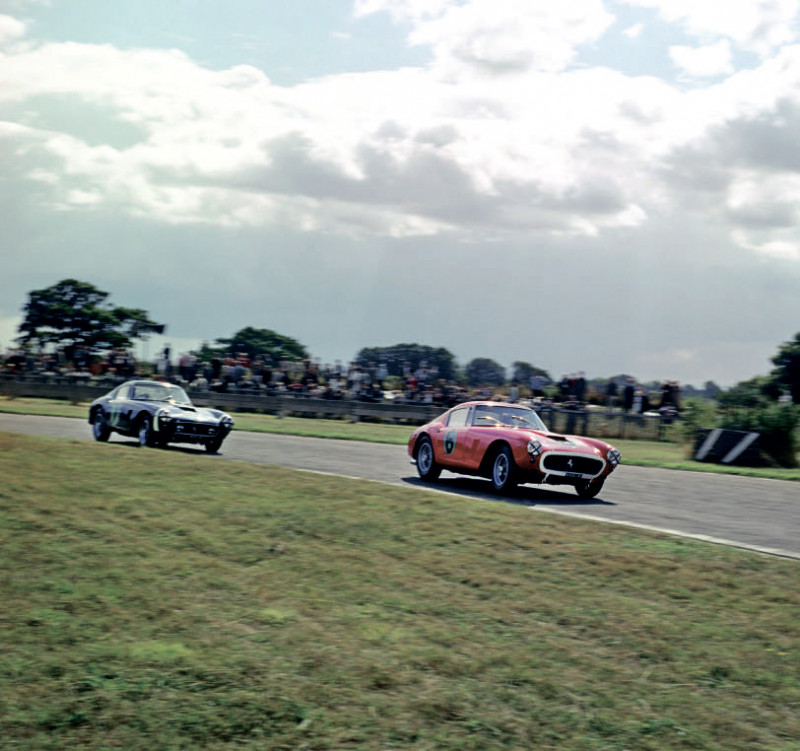
Moss and Mike Parkes (No6) were both racing SWBs at Goodwood in 1961; Parkes gave Moss a battle but would finish second


